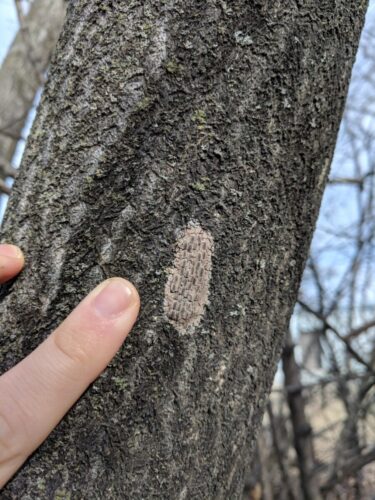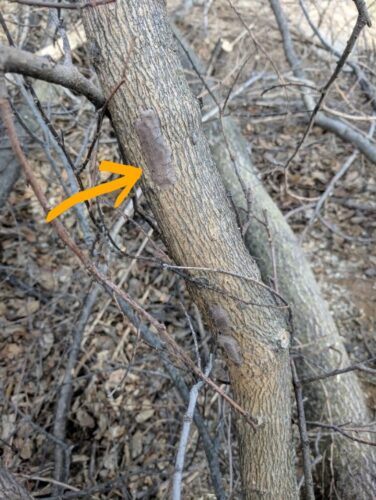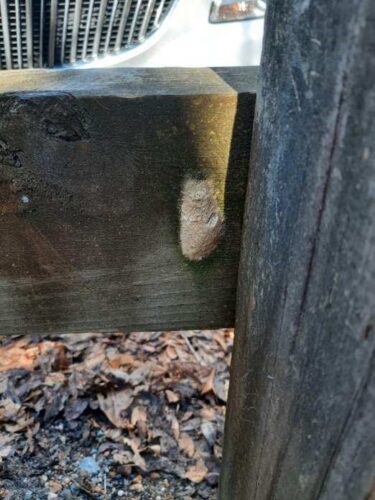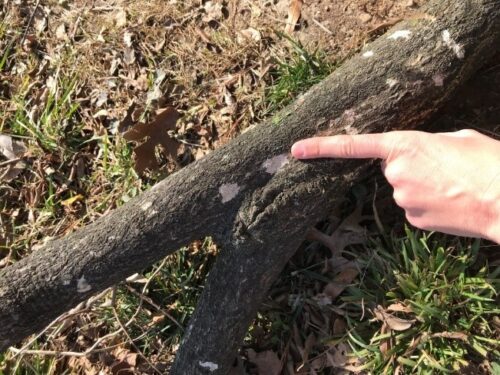Spotted Lanternfly Egg Mass Scouting – DIY!
February 23, 2022 8:53 am

By Lori Chamberlin, VDOF Forest Health Manager
If you are in search of a fun winter activity, look no further! The spotted lanternfly (or SLF, for short), an invasive insect that was discovered in Virginia in 2018, continues to spread, and we need your help finding egg masses. Spotted lanternfly egg masses are laid in the fall, survive through the winter, and then hatch in the spring. Each egg mass contains 30-50 eggs, so finding and destroying these egg masses can make a difference. Learn how to identify them and what to do when you find them.
How to identify SLF egg masses
Spotted lanternfly females lay eggs in rows and then cover the eggs with a protective substance. The covering is white and glossy at first, turns grey/brown when dried, and cracks and fades over time. Sometimes the covering wears off completely, exposing the individual eggs. If nymphs have already emerged, there will be a perfect oval at the top of each egg. The entire egg mass is about 1.5 inches long, and looks similar to a smudge of clay.
- SLF egg mass with covering worn away
- SLF egg mass from a distance
Where to look for SLF egg masses
Spotted lanternfly egg masses are laid on hard surfaces, including trees, stones, outdoor furniture, vehicles, etc. They are often found in protected areas, such as the undersides of tree limbs, branch crotches, and under surfaces like a patio table. Look in areas with a high concentration of tree-of-heaven, a preferred host, and at sites where there is significant movement of people and/or vehicles. Common high-risk sites include truck stops, train stations, parking lots, and trailheads.
What to do when you find them
If you find spotted lanternfly egg masses inside the quarantine zone, smash them and give yourself a pat on the back – you just prevented up to 50 lanternflies from hatching! Egg masses can be smashed with a stick, hand, or scraper card. Just make sure to apply firm pressure as you scrape so that individual eggs burst open. If you find egg masses outside the quarantine zone, take a photo first, and then smash them. If the egg masses are found in a county that is not currently highlighted on the NYS IMP Spotted Lanternfly infestation map, please report the location to the local Virginia Cooperative Extension agent or Virginia Department of Forestry forester.
Common look-alikes
There are many things outside that look similar to spotted lanternfly egg masses. Lichen on tree branches often have the same shape, size, and color. Other insects lay egg masses that may be mistaken for spotted lanternfly. Some commonly found look-alikes are wheel bug eggs and Lymantria dispar egg masses. Wheel bug egg masses do not have a covering, and Lymantria dispar egg masses are generally more fibrous and tanner in color. Use binoculars to get a better look at potential egg masses in the field, and examine the photos below to train your eyes.
- Wheel bug eggs
- Lymantria dispar egg mass
- Surface lichen on tree-of-heaven
Virtual training for volunteers
VDOF has partnered with the Smithsonian Conservation Biology Institute – Virginia Working Landscapes, and Blue Ridge PRISM to present a webinar on Feb 28th for volunteers who wish to participate in spotted lanternfly egg mass surveys. The training will cover the biology and identification of the spotted lanternfly, its current distribution, how and where to conduct egg mass surveys, and how to record data. Register for this webinar and learn some do-it-yourself skills that really make an impact.
Tags: Forest Health Impacts, Invasive Species
Category: Forest Health




